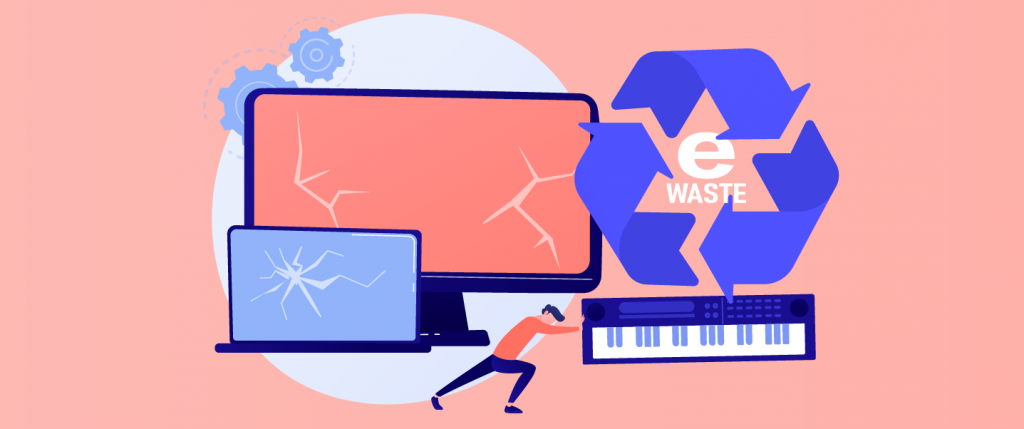Insights
E-Waste Management Rules, 2022: An Overview
April 12, 2023Introduction
India is third largest e-waste generator in the world.[1] The quantity of e-waste generated in FY 2021-22 was 1.6 million and that of e-waste collected and processed was 0.5 million.[2] With the rising number of electric vehicles, electronic devices, solar panels, etc. due to the push towards digital economy, electric mobility and renewable energy, this waste will significantly increase in India. Realising the urgency, the Government has notified the E-Waste Management Rules, 2022 (“2022 Rules“) for environmentally sound management of e-waste which supersedes E-Waste Management Rules, 2016 (“2016 Rules“). Since the 2022 Rules have come into effect from 01 April, 2023, mentioned below are some key changes introduced in the 2022 Rules vis-à-vis 2016 Rules.

- Scope of application
The 2016 Rules were applicable to “every manufacturer, producer, consumer, bulk consumer, collection centres, dealers, e-retailer, refurbisher, dismantler and recycler involved in manufacture, sale, transfer, purchase, collection, storage and processing of e-waste or electrical and electronic equipment listed in Schedule I…” However, 2022 Rules apply to “every manufacturer, producer, refurbisher, dismantler and recycler involved in manufacture, sale, transfer, purchase, refurbishing, dismantling, recycling and processing of e-waste or electrical and electronic equipment listed in Schedule I….”. It appears that the Government intends to improve the regulatory oversight over e-waste ecosystem by specifically regulating only a limited type of persons playing a major role in it.
Read More+
- Scope of e-waste
The 2016 Rules covered only 21 types of electrical and electronic equipment under two broad categories, i.e., information technology and telecommunication equipment and consumer electricals and electronics. However, the 2022 Rules have expanded the scope to more than 100 types of equipment covered under seven broad categories in Schedule I (“Covered Items“). Some of the newly (and timely) added equipment are tablets, GPS, modems, electronic storage devices, solar photovoltaic panels/cells/modules, air purifiers, leisure and sports equipment, medical devices, laboratory instruments, etc.
- Registration requirements
The 2016 Rules required a producer to obtain authorization from Central Pollution Control Board (“CPCB“), whereas, manufacturer, refurbisher, dismantler or recycler required authorization from the relevant State Pollution Control Board (“SPCB“) or Union Territory Pollution Control Committee (“UTPCC“). However, the 2022 Rules require all regulated persons – manufacturer, producer, refurbisher and recycler to register on CPCB’s online portal. No such entity shall operate without registration and shall also not deal with any entity that falls under these categories but is unregistered.
- E-waste management compliances
The 2022 Rules define producer as a person who: manufactures and sells Covered Items under own brand; offers to sell assembled Covered Items under own brand; offers to sell imported Covered Items; and imports the used Covered Items. The 2016 Rules defined extended producer responsibility (“EPR”) for producers as channelization of e-waste to ensure environmentally sound management of such waste through appropriate mechanism. However, under EPR, the 2022 Rules require producers to meet recycling targets as per Schedule III and Schedule IV only through registered recyclers of e-waste to ensure environmentally sound management of such waste. Schedule III and Schedule IV prescribe the e-waste recycling targets for producers from year 2023-24 onwards.
Producers are required to fulfill their EPR targets through online purchase of EPR certificate only from registered recyclers and submit it by filing quarterly return on the CPCB portal. These certificates will be generated for recycler and refurbisher based on the quantity of Covered Items processed by them. Recycling certificate will set off EPR targets of the producer, whereas refurbishing certificates will only defer them. Producer can purchase EPR certificates up to a total of: EPR liability of current year, leftover liability of preceding years, and 5% of the current year liability. The detailed EPR mechanism was not provided in the 2016 Rules. Non-compliance with these provisions will attract environmental compensation and prosecution under Environment (Protection) Act, 1986.
- Management of solar photo-voltaic modules, panels or cells
The 2022 Rules provide specific responsibilities for persons manufacturing or producing solar photo-voltaic modules, panels or cells. They are required to inter alia register on CPCB portal; maintain inventory of these items on CPCB portal; ensure storage of e-waste generated up to year 2034-35 as per CPCB guidelines; and file online annual returns. CPCB will issue guidelines regarding storage of such waste and recovery of material from recycling of such waste. This aspect was not provided in the 2016 Rules.
- Bulk consumer definition and responsibilities
The 2016 Rules provided two categories – consumer and bulk consumer, where latter included juridical persons like government departments, educational institutions, companies, etc. Both were required to segregate the e-waste and channelize it to authorized dismantler or recycler. Bulk consumer was required to prepare records of e-waste generated by it and file annual returns with relevant SPCB or UTPCC.
However, Rule 3(1)(b) of 2022 Rules defines ‘bulk consumer’ as “any entity which has used at least one thousand units of electrical and electronic equipment listed in Schedule I, at any point of time in the particular Financial Year and includes e-retailer”. It is required to hand over e-waste only to registered producer, refurbisher or recycler. The requirement to submit compliance documents and the separate category of consumer have been removed.
Conclusion
The 2022 Rules are a well-intended and well-timed intervention by the Government to legislate on a subject of major concern as the 2016 Rules excluded many equipments that are widely in use today and will become e-waste tomorrow. For instance, demand for solar equipment will significantly increase due to the rapid expansion of renewable energy in India which will eventually generate e-waste in the near future. It will also address the lack of real-time data on e-waste in India, considering that the data presented by the Government before the Parliament covered only 21 equipment covered under 2016 Rules and excluded a large number of other equipment generating e-waste. The 2022 Rules will also streamline different aspects for regulated persons like registration requirements, submission of compliance documents, EPR targets and certificates, etc. with other waste related legislations like Plastic Waste Management Rules, 2016 and Battery Waste Management Rules, 2022, thereby ensuring the ease of compliance.
Footnote
[1] https://pqars.nic.in/annex/259/AU267.pdf
[2] https://pqars.nic.in/annex/259/AS5.pdf
This article was originally published in Mondaq on 12 April 2023 Co-written by: Nawneet Vibhaw, Partner; Himanshu Pabreja, Associate. Click here for original article
Read Less-
Contributed by: Nawneet Vibhaw, Partner; Himanshu Pabreja, Associate
Disclaimer
This is intended for general information purposes only. The views and opinions expressed in this article are those of the author/authors and does not necessarily reflect the views of the firm.


